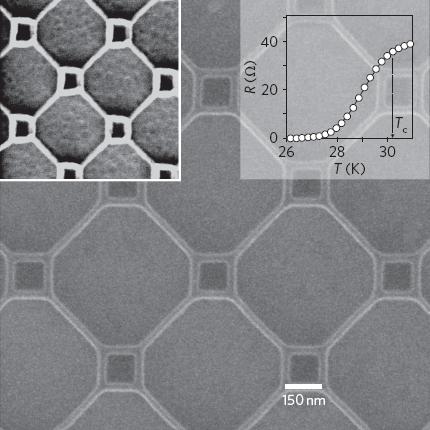The fluctuating response of the material to a magnetic field may lead to the creation of superconducting wires that can be switched and actually produce completely new electronics, much faster and stronger than what exists today * The new materials function at relatively high temperatures, which are cheap and practical to cool down to

A team of scientists from Bar Ilan University, in collaboration with researchers at the Brookhaven National Laboratory belonging to the Department of Energy in the US federal government (DOE), produced thin films containing large arrays of superconducting nanowires and nanoscale loops capable of carrying an electric current without resistance when cooled to a temperature of 30 degrees Kelvin (-243 degrees Celsius). The scientists showed that they could cause fluctuations in the material's electrical resistance by exposing it to a magnetic field.
"Superconducting nanowires and nanoloops may be useful in a selection of new electronic components - this is the long-term vision," said Prof. Yosef Yeshuron, head of the Center for Superconductivity at Bar-Ilan University, who led the project together with Prof. Avner Shaolov and research student Ilya Sushnikov .
Yeshuron and his colleagues described the research in the journal Nature Nanotechnology, and it was published in the online version of Nature Nanotechnology on June 13.
The production of nanometer-scale superconducting wires is a long-term dream. Such wires could enable the development of faster and more powerful electronics. However, this turned out to be difficult if not impossible using conventional superconductors, because the minimum size of a material sample to be a superconductor is too large. For example, in the case of niobium - the most common superconductor, it is about 40 nanometers. Tiny nanometer wires made of this material will not behave as superconductors.
However, in superconductors containing layers of copper and oxygen, it is theoretically possible to preserve the superconducting properties down to a few nanometers. Also the fact that the materials function at relatively high temperatures reduces their cooling costs, which makes them attractive for real-world tasks.
To see if it is possible to achieve superconductivity in thin films that are "carved" so that patterns of "wires" are formed in them - much like the printing of circuits into computer chips - the Brookhaven team, led by Dr. Ivan Bozovic, began to produce thin layers of conductors- On, one layer of atoms at a time.
Bar Ilan's team then used electron beam lithography to burn a pattern of thousands of loops into the surface of the material. The diameter of those nanowires formed on the sides of these loops was 25 nanometers, while the length ranged from 150 to 500 nanometers. Measurements of the electrical resistance of the pattern arrays showed that they were indeed superconducting when cooled below 30 degrees Kelvin.
When the scientists applied a magnetic field perpendicular to the loops, they discovered that the resistance of the loops did not increase according to the strength of the field, but increased and decreased in a cyclical/oscillating manner.
"These fluctuations in resistance have a high amplification capability and their frequency corresponds to quantum units of the magnetic flux - the measurement of the strength of the magnetic field penetrates the loops, says Yeshuron. "A material with such a mode of magnetic resistance, especially from a superconducting state to a state where it is not superconducting could be very useful for engineering new devices."
The frequency of resistance fluctuations as observed may have implications for understanding the mechanism by which materials become superconductors in general. The present findings appear to rule out some recently proposed theoretical models. A better understanding of the conduction mechanism may lead to progress in the development of new materials for practical applications.
The research was funded by the Fund for Joint Projects between Israel and Germany, the Energy Department of the US Federal Government, and a scholarship from the Israeli Ministry of Science.

3 תגובות
Kudos to the scientists. Doing holy work.
It will be exciting to implement clinical studies that will be successful in humans. in the field of genetic engineering. and medicine.
More important here is not the electronics that can now be developed based on the findings (which still require cryogenic cooling that is more expensive than liquid nitrogen), but the implications for basic research in superconductivity. If I understood correctly, then they succeeded in creating what they created but without a full understanding of the phenomenon. The continuation is in the study of the phenomenon and, by the way, perhaps the understanding of superconductivity mechanisms on a new level, which may lead to the long-awaited goal - superconducting materials at room temperature, including on a nanometer scale.